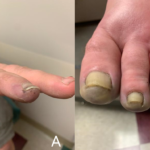Sero-negative APS: I assume that all of us see patients with many of the hallmarks of APS, including arterial thrombosis, thrombocytopenia, valve lesions, recurrent pregnancy loss, and so on, in whom aPL tests remain doggedly negative. Explanations for this situation might include wrong diagnosis, a disappearance of antibodies over time, or simply that more aPL-related tests are needed. As a clinician, however, I believe that the concept of sero-negative APS is useful, just as sero-negative RA and sero-negative lupus were decades before.15
Anecdotes for the Clinically Curious
Neurological features of APS almost certainly embrace sleep disturbance. In my clinic, I have an extended family with both APS and autism, which may just be a clinical coincidence. Three of my patients have developed acute anosmia. Peripheral and autonomic nerve problems and cases of reflex dystrophy are also being described. As in diabetes, it may be that ischemia of peripheral nerves renders them more sensitive to external pressure. One of my APS patients with lumbar disc disease and severe symptoms of spinal stenosis and claudication improved once anticoagulation was started. Fatigue, as in lupus, is a frequent and major complaint, and often improves significantly once anticoagulation is started. More difficult to explain, but certainly a frequent observation, is the improvement in the arthralgia (in primary APS) with anticoagulants.
Table 1 (see below) gives a list of features which I believe are of help in diagnosis—certainly useful in the differentiation from other coagulopathies.
Treatment
The indications for aspirin (or clopidogrel), heparin, and warfarin are reviewed in detail elsewhere, and I will restrict this section to three specific comments.
First, the use of a two- to three-week heparin trial in APS patients with severe frequent headache but with normal MRIs may be informative. Although a “soft” diagnostic tool with significant placebo input, in some patients the improvement or even abolition of headache and migraine with a course of self-administered heparin (e.g., Fragmin 10,000 units daily) gives some support to the difficult decision to move to warfarin.
Second, it is important to achieve a therapeutic INR with warfarin, ideally with a self-testing INR machine. There is probably no overall correct INR. Usually, arterial thrombosis appears to require a higher INR than venous. In neurology, however, we frequently see a higher INR requirement (e.g., 3.5–4), with the headaches, TIA, and memory impairment predictably returning when the INR falls below, for example, a precise reading of 3.4. For such patients, the use of self-testing machines is as important to a reasonably normal life as is self-measurement of insulin dose in some diabetics.

